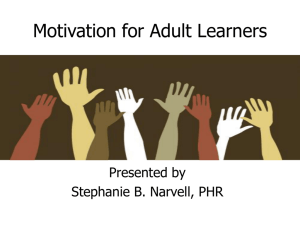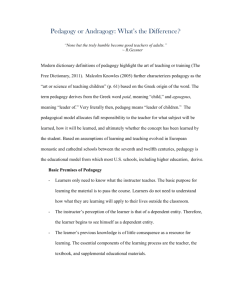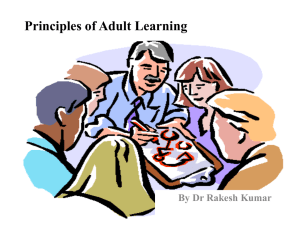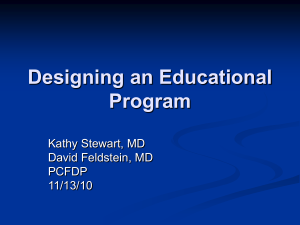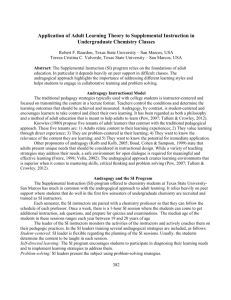Pedagogy vs Andragogy
advertisement
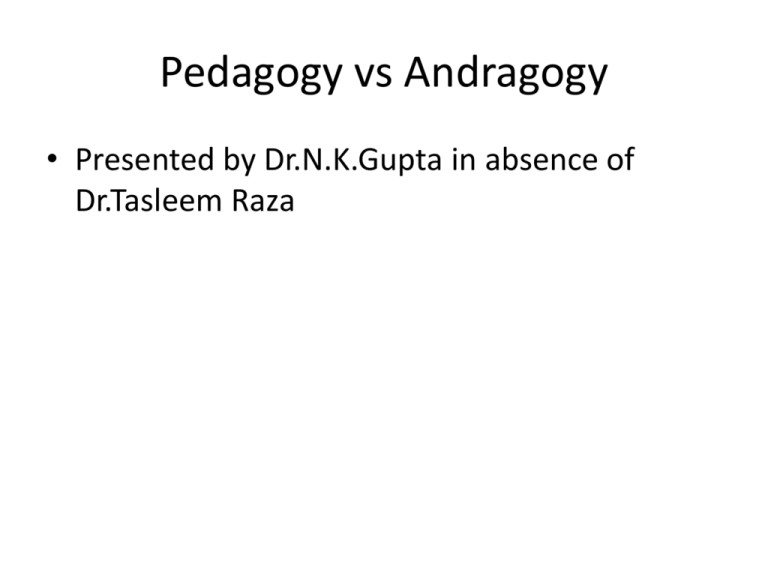
Pedagogy vs Andragogy • Presented by Dr.N.K.Gupta in absence of Dr.Tasleem Raza Pedagogy vs. Andragogy Dr. S. Tasleem Raza Department of Biochemistry Era’s Lucknow Medical College, Lucknow. To know andragogy and pedagogy Principles of adult learning and the Differences between pedagogy and andragogy. Pedagogy •Pedagogy is a term derived from the Greek words paid (meaning "child") and agogus (meaning "leading"). •So "pedagogy" means, literally, the art and science of teaching children (Knowles, 1973) About Pedagogy •Evolved in the monastic schools of Europe in 7th12th centuries. •concerned teaching young children relatively simple skills mostly reading and writing. •Model was adopted and reinforced with the spread of elementary schools throughout Europe and North America. •Infact not much knowledge about learning until studies on adult learning began to appear after World War II. Drawbacks of Pedagogy • Adult education began to be organized systematically during the 1920s •Teachers of adults began experiencing several problems with the pedagogical model. •Pedagogy was based on the premise that the purpose of education was the transmittal of knowledge and skills. •Adult learners seemed to feel this was insufficient and frequently resisted teaching strategies that pedagogy prescribed, such as lectures, assigned readings, quizzes, note memorizing, and examinations. • Dropout rates were high. •Teachers also noted that many of the assumptions about the characteristics of learners in the pedagogic model did not fit their adult students. Andragogy •The term andragogy was coined in 1833 by the German teacher Alexander Kapp. •Andragogy is based on the Greek word aner with the stem andra meaning "man, not boy" or adult, and agogus meaning "leader of." •Andragogy was first introduced to the United States in 1927 by Martha Anderson and Eduard Linderman, but they did not attempt to develop the concept . •The goal of adult education should be self-actualization; thus, the learning process should involve the whole emotional, psychological, and intellectual being. •The mission of adult educators is to assist adults to develop their full potential, and andragogy is the teaching methodology used to achieve this end. About Andragogy Andragogy is premised on four crucial assumptions about the characteristics of learners that are different from the assumptions on which traditional pedagogy is premised. These assumptions are that as individuals mature: 1) Their self-concept moves from one of being a dependent personality toward being a self-directed human being. 2) They accumulate a growing reservoir of experience that becomes an increasingly rich resource for learning. 3) Their readiness to learn becomes oriented increasingly to the developmental tasks of their social roles. 4) Their time perspective changes from one of postponed application of knowledge to immediacy of application, and accordingly, their orientation toward learning shifts from one of subject-centeredness to one of performancecenteredness . Examples of some objections: •Houle (1972) preferred to view education as a single fundamental human process and the learning activities of men and women were essentially the same as those of boys and girls. •He was joined by London (1973) and Elias (1979) who preferred to stress the oneness or unity in education •In 1980, Knowles objected by stating that there were occasions when andragogy might be used with children and pedagogy with adults. Characteristics of Learners ADULT LEARNERS YOUTH LEARNERS Problem-centered Results-oriented Self-directed Often skeptical about new information Seek relevancy Accepts responsibility for own learning Subject-oriented Future-oriented Often depend on adults for direction More accepting Often train for unclear future Often dependent on others Principles of Adult Learning Jane Vella (2002) sets out 12 principles for adult learning: 1. Needs assessment - participation of the learners in naming what is to be learned. 2. Safety in the environment and the process. create a context for learning. That context can be made safe. 14 3. Sound relationships between teacher and learner and among learners. 4. Sequence of content and reinforcement. 5. Praxis - action with reflection or learning by doing. 6. Respect for learners as decision makers. 7. Ideas, feelings, and actions - cognitive, affective, and psychomotor aspects of learning. 8. Immediacy of the learning. 9. Clear roles and role development. 10. Teamwork and use of small groups. 11. Engagement of the learners in what they are learning. 12. Accountability - how do they know ? Pedagogy vs. Andragogy Differences based on Beliefs (Mental Models) Topic Traditional Pedagogy Andragogy Perception of Nature of Work Necessary evil Vehicle for self-expression Organization Design Bureaucracy Reduced hierarchy, team based high performance Organization Goals Stable, slow-changing, highly structured performance Dynamic, fast-changing, continuous improvement Topic Traditional Pedagogy Andragogy Organization Climate Authority-oriented Formal/closed Competitive Respect-oriented Informal/open Collaborative Diagnosis of Needs Supervisor Mutual/self-diagnosis Purpose of Intervention Orientation, Standardization, Instruction (acquisition of existing knowledge) Change, Development, Creation of new knowledge Employee Competence Below minimum acceptable performance Above minimum acceptable performance Differences based on Underlying Assumptions Topic Traditional Pedagogy Andragogy Learners/employees Dependent Independent Subject matter One right way Many ways Motivation to learn, change, or improve External, dictated by others Internal, response to personal/career needs Topic Traditional Pedagogy Andragogy Role of experience Unimportant or even discounted A rich resource that can be the basis for learning, change or improvement Must be integrated Learner/employee self concept Need outside direction Capable of self-direction Learning orientation Subject-centered Logic-oriented Life/career-centered Process centered Objective Minimum requirements Self-betterment Differences based on Consequent Learning Design Topic Traditional Pedagogy Andragogy Identification of Need Mandate from above Choice of learning motivated by life enhancement or performance improvement expectation Instructional Design Transmission of prescribed subject matter through lectures, Socratic dialogue, and memorization Subject matter is life centered, task-centered, problem centered and learning is facilitated, self-reflective and transformative Topic Traditional Pedagogy Andragogy Learning Process Passive learning Active Learning Instruction, memorization, modeling, demonstration, coaching, etc. Critical and reflective thinking, shared visioning. Simulations through team learning, case studies, role playing, etc. On the job experience, new information, interpretation, practice, adaptation, and integration. Experiential learning such as creative thinking, improvisation, ropes courses, etc. Conclusion 1. Andragogy is an adult focused teaching approach while Pedagogy is a child focused teaching approach. 2. Andragogy is motivational
